
Eta Carinae, formerly known as Eta Argus, is a stellar system containing at least two stars with a combined luminosity greater than five million times that of the Sun, located around 7,500 light-years distant in the constellation Carina. Previously a 4th-magnitude star, it brightened in 1837 to become brighter than Rigel, marking the start of its so-called "Great Eruption". It became the second-brightest star in the sky between 11 and 14 March 1843 before fading well below naked-eye visibility after 1856. In a smaller eruption, it reached 6th magnitude in 1892 before fading again. It has brightened consistently since about 1940, becoming brighter than magnitude 4.5 by 2014.
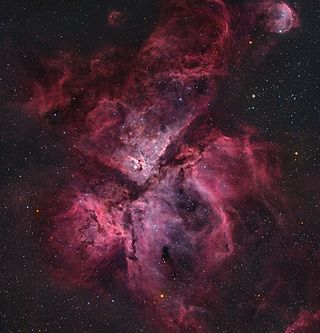
The Carina Nebula or Eta Carinae Nebula is a large, complex area of bright and dark nebulosity in the constellation Carina, located in the Carina–Sagittarius Arm of the Milky Way galaxy. The nebula is approximately 8,500 light-years (2,600 pc) from Earth.

Luminous blue variables (LBVs) are massive evolved stars that show unpredictable and sometimes dramatic variations in their spectra and brightness. They are also known as S Doradus variables after S Doradus, one of the brightest stars of the Large Magellanic Cloud. They are considered to be rare.

P Cygni is a variable star in the constellation Cygnus. The designation "P" was originally assigned by Johann Bayer in Uranometria as a nova. Located about 5,300 light-years from Earth, it is a hypergiant luminous blue variable (LBV) star of spectral type B1-2 Ia-0ep that is one of the most luminous stars in the Milky Way.

Plaskett's Star, also known as HR 2422 and V640 Monocerotis, is a spectroscopic binary at a distance of around 6600 light-years. It is one of the most massive binary stars known, with a total mass of around one hundred times that of the Sun. Indeed, it was long thought to be the most massive known binary system, but evidence collected between 1996 and 2005 demonstrated that Eta Carinae, which was previously thought to be a massive individual star, is a binary system.
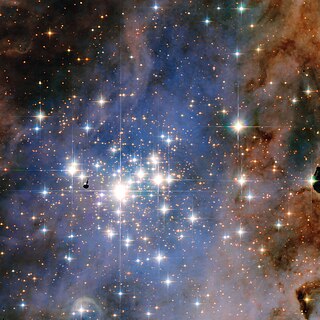
HD 93129 is a triple star system in the Carina Nebula, with all three components being hot O class stars amongst the most luminous stars in the Milky Way. It is the dominant member of the Trumpler 14 star cluster, a young star cluster within the Carina OB1 stellar association that harbors other super-luminous stars, like Eta Carinae and WR 25.

HD 95109 is a Classical Cepheid variable, a type of variable star, in the constellation Carina. Its apparent magnitude is 6.86.

HD 93205, or V560 Carinae, is a binary stellar system, in the Carina Nebula in the constellation Carina. It consists of two massive O-stars that revolve around each other in 6 days.

HR Carinae is a luminous blue variable star located in the constellation Carina. It is surrounded by a vast nebula of ejected nuclear-processed material because this star has a multiple shell expanding atmosphere. This star is among the most luminous stars in the Milky Way. It has very broad emission wings on the Balmer lines, reminiscent from the broad lines observed in the spectra of O and Wolf–Rayet stars. A distance of 5 kpc and a bolometric magnitude of −9.4 put HR Car among the most luminous stars of the galaxy.
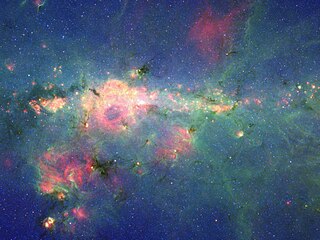
WR 102ka, also known as the Peony star, is a slash star that is one of several candidates for the most luminous-known star in the Milky Way.

A hypergiant (luminosity class 0 or Ia+) is a very rare type of star that has an extremely high luminosity, mass, size and mass loss because of its extreme stellar winds. The term hypergiant is defined as luminosity class 0 (zero) in the MKK system. However, this is rarely seen in literature or in published spectral classifications, except for specific well-defined groups such as the yellow hypergiants, RSG (red supergiants), or blue B(e) supergiants with emission spectra. More commonly, hypergiants are classed as Ia-0 or Ia+, but red supergiants are rarely assigned these spectral classifications. Astronomers are interested in these stars because they relate to understanding stellar evolution, especially star formation, stability, and their expected demise as supernovae. A common example of a hypergiant is UY Scuti, although being a supergiant UY Scuti is considered a hypergiant by some people.

NGC 2363-V1 is a luminous blue variable star in the star-forming region NGC 2363, at the far southwestern part of the irregular galaxy NGC 2366 in the constellation Camelopardalis, near the north celestial pole nearly 11 million light years away from our galaxy. It was discovered in 1996 by Laurent Drissen, Jean-René Roy, and Carmelle Robert while examining images taken by the Hubble Space Telescope Wide Field Planetary Camera 2.

AFGL 2298, also known as IRAS 18576+0341, is a luminous blue variable star (LBV) located in the constellation Aquila, very close to the galactic plane. Its distance is not well known; it may be anywhere between 23,000 and 42,000 light years away from the Earth. Despite being extremely luminous, it is extremely reddened by interstellar extinction, so its apparent magnitude is brighter for longer-wavelength passbands; in fact, in visual wavelengths it is completely undetectable.
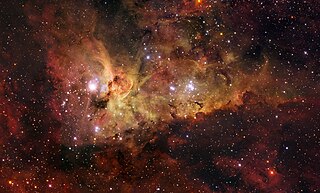
Trumpler 16 is a massive open cluster that is home to some of the most luminous stars in the Milky Way galaxy. It is situated within the Carina Nebula complex in the Carina–Sagittarius Arm, located approximately 9,270 ly (2,842 pc) from Earth. The cluster has one star visible to the naked eye from the tropics southward, Eta Carinae.

Haro 11 (H11) is a small galaxy at a distance of 300,000,000 light-years (redshift z=0.020598). It is situated in the southern constellation of Sculptor. Visually, it appears to be an irregular galaxy, as the ESO image to the right shows. H11 is named after Guillermo Haro, a Mexican astronomer who first included it in a study published in 1956 about blue galaxies. H11 is a starburst galaxy that has 'super star clusters' within it and is one of nine galaxies in the local universe known to emit Lyman continuum photons (LyC).
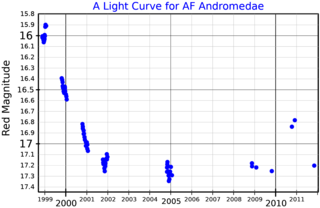
AF Andromedae is a luminous blue variable (LBV), a type of variable star. The star is one of the most luminous variables in M31, the Andromeda Galaxy.

The Sunburst galaxy is a strongly magnified galaxy at redshift z=2.38 behind the galaxy cluster PSZ1 G311.65-18.48. The cluster acts as a power magnifier thanks to the gravitational lensing effect. The galaxy cluster distorts the space around it creating different paths for the photons coming from the Sunburst galaxy. This lensing creates four arc segment roughly following a circle around the foreground lensing cluster. Chance alignments of the Sunburst Galaxy and galaxies in the lensing cluster breaks up some of the arc segments into multiple smaller images, creating a total of 12 full or partial images of the galaxy along the arc; some of these images are magnified by very large factors. In one of these strongly magnified images of the Sunburst galaxy, astronomers have identified the most luminous star known to date, Godzilla.

















